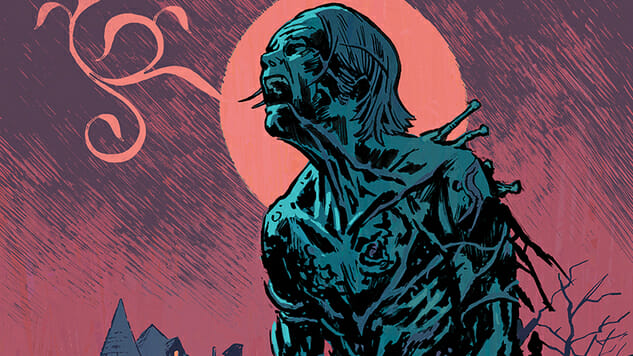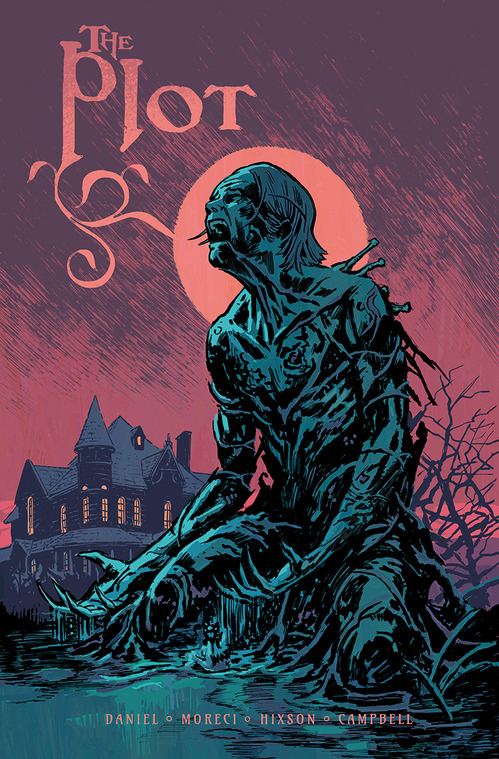Tim Daniel & Michael Moreci Reveal the Cinematic Horrors Behind The Plot
The Co-Writers of the Upcoming Vault Comics Horror Series Discuss Their Film Influences
Art by Joshua Hixson Comics Features Vault Comics
Just a few short weeks ago, Paste broke the news that Vault Comics is launching an annual horror program called Nightfall. Designed as something of a pop-up imprint, Nightfall’s icon will grace a select number of Vault titles launching between September and December each year, assuring readers that they can expect genuine frights within. While Nightfall titles will launch within a specific window annually, they’ll then continue to release like other Vault periodicals, until each title’s planned conclusion.
It’s still too early to share an interior look at Nightfall’s inaugural title, The Plot, but we invited co-writers Tim Daniel and Michael Moreci to discuss some of the biggest cinematic (as well as a few literary) influences behind their upcoming horror outing. Check those essays out below, along with artist Joshua Hixson’s cover for the first issue. The Plot launches from Vault Comics’ Nightfall imprint this September.
![]()

The Plot #1 Cover Art by Joshua Hixson
The Plot Co-Writer Tim Daniel:
If cinematic horror has a name, it would be Bob Wilkins. Probably does not ring a bell if you didn’t grow up in the San Francisco Bay Area during the 1970s, but you might recognize Bob Wilkins in the guise of such modern-day counterparts as Joe Bob Briggs or Svengoolie.
Late every Saturday night, Wilkins would first light his cigar then the candle atop the skull adjacent to his rocking chair and welcome viewers (like me) to Creature Features. Gently mocking himself and his station, KTVU, for airing the often obscure and arcane independent horror movies he introduced each week, Wilkins was dry to the point of droll. He was horror’s low-budget analog to Letterman. Adorned in a suit and tie, complete with polished loafers and square-rimmed black glasses, Wilkins was a nerd’s nerd when it came to horror. Part historian and soft-spoken professor, part behind-the-scenes proxy, Wilkins was a Blu-ray special feature long before such things existed.
I watched with loyal resolve every weekend, fighting off pre-teen drowsiness in hopes of catching an iconic film from studios such as Hammer, Toho or Universal. Obviously, I didn’t know then the significance those production houses would hold in horror movie lore until much later, but it was Bob Wilkins that served as my cracked window into understanding that horror is in fact, exceedingly broad in scope. Horror is elastic and malleable. Horror is many-faced and many-formed. Horror is creeping tendrils of fog and glowing eyes in darkened hallways. Horror is dank sewers and dark woods. Horror is slamming doors and rotating heads—thundering kaiju and societal dread. Horror is psychological, supernatural, internal, external, infernal and eternal.
Maybe that’s why driving a stake through the cinematic horror influences for my new Vault Comics series The Plot with co-writer Michael Moreci is so difficult. I find myself cutting one head off the list and watching three new ones grow back in its place.
But in order to survive this crucible, maybe it’s best to return to a film Bob Wilkins introduced me to all those many years ago, Matango: Attack of the Mushroom People. Atmospheric and weird, the film is indelibly jarring because of its practical make-up effects, particularly when the shipwrecked survivors begin to transform into humanoid fungi. There’s something unnerving about witnessing humanity die at the hands of the emerging monster (see Cronenberg’s The Fly). Matango greatly influenced my first published series, Enormous, and its visuals helped inform the design of our creature in The Plot.
Alien. Do we need to debate this? It’s horror. In space. Ridley Scott gave us a haunted house complete with an alien Michael Myers. The Nostromo is a sometimes very wet and often very dark labyrinth much like the Blaine house and its surrounding grounds. And just like Chase Blaine in The Plot, the only way to try and stop an unstoppable evil is to face it—head on.
The Fog. Directed by John Carpenter. By now you’re probably sensing the atmosphere of The Plot will be driven by imagery that is both dark and wet and with good reason—at the heart of this tale there is a bog. Their very nature suggests something a little sinister perhaps—the notion that bogs are a place of decay. The use of an article for the title of both The Fog and The Plot makes both much more aggressive, even predatory—which is to suggest that the Blaine house and land upon which it is situated possesses those very qualities.
The Mist. Frank Darabount’s adaptation of Stephen King’s classic novella centers on a random selection of people trapped in their local supermarket by an impenetrable mist concealing unearthly creatures. There has not been a more courageously unflinching end to a commercial film in recent memory. The script plays rough with the lead character and the viewer (hint: Mike and I often strive to do the same to our characters and readers with The Plot). The film is most effective for instance, when we are left to imagine what seizes upon the other end of the rope tethering a brave survivor to the supermarket as he ventures into the mist-shrouded parking lot. We’ll be giving readers plenty of opportunity to do the same—filling the gaps and spaces of the mystery that has burdened the Blaine family for generations.
It Follows. Walloping tension drives this film. David Robert Mitchell’s film grips immediately, pushes forward and relentlessly pursues. The tempo is crisp, and the key beats are expertly paced. Its “monster” shifts form, jumping from person to person and our series will employ something very similar, but also different.
And that’s because as Bob Wilkins taught me, horror is elastic and malleable. Horror has many faces and takes many forms. You might see a stranger watching you at the edge of a hedge down the block, or the face of a distant ancestor peering over your shoulder in the bathroom mirror, or perhaps a bog monster crawling from the bottomless black abyss on the edge of the family plot.
![]()

Nightfall Promotional Art by Joshua Hixson & Tim Daniel
The Plot Co-Writer Michael Moreci:
When I think about cinematic horror that’s left the most indelible mark on my life and career, there’s a common thread that unites my most beloved classics. See, I’m not much of a gore guy. Sure, I love me some Friday the 13th—in Camp Crystal Lake, New York City, Hell and in space—but there’s a certain amount of camp (pun fully intended) that prevents those movies from being truly sadistic. Because oftentimes, what goes hand in hand with excessive gore is excessive cruelty for the sake of cruelty. Now, look: horror has the power to be a lot of different things. That’s part of the genre’s beauty. Me? I’m not into the physical torture that horror inflicts on its characters. No—I want the emotional torture. I want my characters rung out like a dishrag by the time everything’s said and done, and then I want them wrung out again.
Sounds twisted, I know, but it’s true. The horror that gets under my skin is the horror that nests itself inside my brain and unlocks doors—doors blocking my deepest, most personal fears—that I’d rather keep shut. Tightly. I love horror that makes you see the futility of human society, the nightmare of a being a parent, the ever-present death lurking in all of our lives.
The two horror comics that I’ve written—Curse and Burning Fields, both with Tim Daniel—were both firmly rooted in very simple, yet very palpable, horror. While Curse is a werewolf story, it’s also the story of a father feeling powerless to help his son. That fear is common to all parents, at all times; we live fearing that something terrible will happen, terrible enough that, despite our best efforts, we won’t be able to do anything to stop it. Laney Griffin’s son, Jaren, is dying from cancer. Laney’s insurance is more of an impediment than a means to secure proper care. He’s at the end of his rope, living in the embrace of his worst fears come to life. A werewolf enters this equation, yes. But the true horror is Laney’s deeply personal horror. He feels it; we feel it.
Burning Fields, on the other hand, is a creature feature. It’s broader than Curse, but it also comes from an intimate fear that was rooted deep within me at the time. In the shadow of the U.S.’s many conflicts in the Middle East and the rise of ISIS, what if the monsters that haunt us are the monsters we ourselves are responsible for creating? Investigator Dana Atkinson returns to Iraq, after being dishonorably discharged from the military, to discover her worst fears have come true: all the terrible things she bore witness to, the terrible things she couldn’t prevent, have birthed something unimaginably terrifying. And while the monster itself is scary, the onus of Dana’s responsibility—her duty and the duty we all share to make this world a better place—is the real horror.
Which brings us to my forthcoming series, The Plot, coming from Vault Comics in September of 2019. What inspired it? Where does the horror come from? Well, like Curse (werewolves) and Burning Fields (monsters), the flashy horror conceit is simple and classic: a haunted house. But The Plot is about much more than a haunted house. It’s about a family’s wellness as they struggle with the burden of their own history; it’s about a man, Chase Blaine, trying to free himself of the sins and mistakes of the past and learn how to carve out a new, better way for himself and everyone else who’ll follow in his family tree. It’s the most personal and emotional book I’ve ever written, and the scares come from this infinitely understandable place—that of wanting to do better, to be better, but not knowing how.
My inspirations for it? The most obvious is The Haunting of Hill House, Mike Flanagan’s heart-wrenching, terrifying, beautiful masterpiece. Though Tim and I were already neck-deep in developing The Plot by the time Hill House aired, I still took away so much from that series, particularly the way Mike developed his emotional beats and his approach to trauma. And those quiet, subtle scares? That’s my wheelhouse right there.
Burnt Offerings, Robert Marasco’s excellent novel (rediscovered by Valancourt Books, god bless their hearts) provided a nice lesson in psychological haunted houses stories that relied on family and psychological disintegration. Locke and Key, of course, is something I study whether I’m telling a horror story or not.
Thinking more in general—and going back to my points about horror that I made earlier—subtle, unnerving horror tales are never far from my mind. It Follows, The Babadook, Hereditary, The Thing (Carpenter is god, y’all), The Conjuring series, even the original Halloween (did I mention Carpenter is god?), which is a master class in how, in horror, less can be so very, very much more.
All of these things and more are imprinted on my DNA, and the DNA of The Plot. And you’ll be able to see it for yourself soon—because we’re just three short months from issue #1 being unleashed onto the world.
The past is coming for Chase Blaine—but can he finally break the cycle that has cursed his family for generations? Can he save himself and the people he loves? Find out this September…